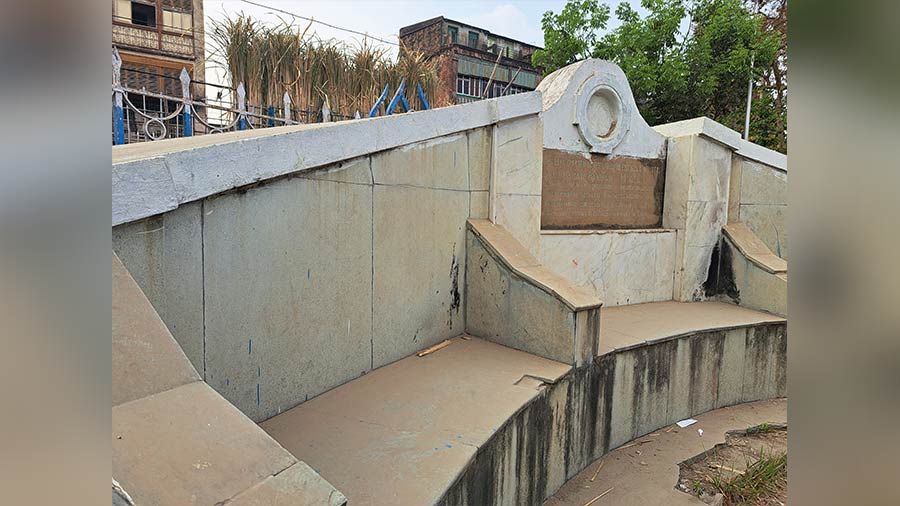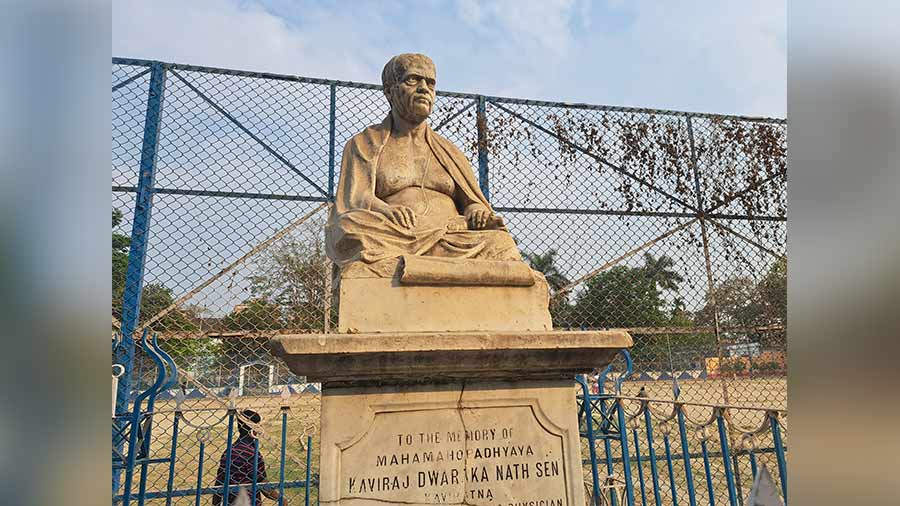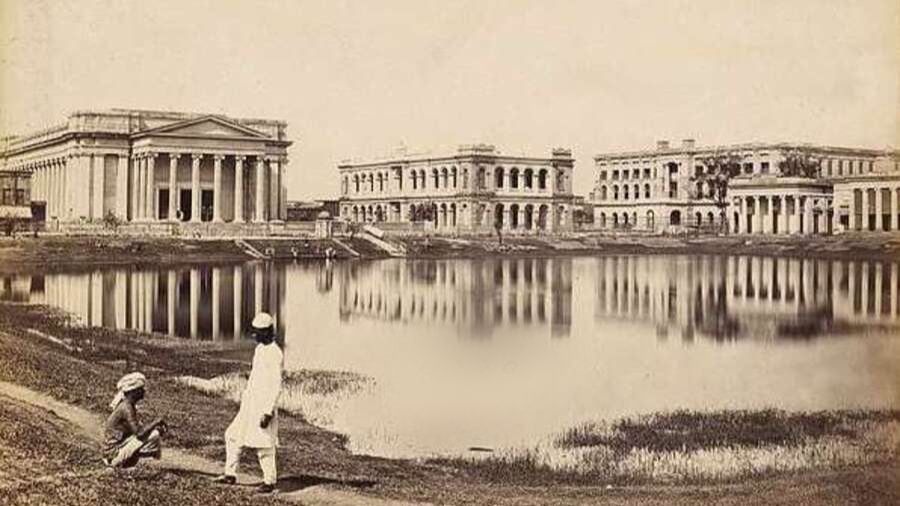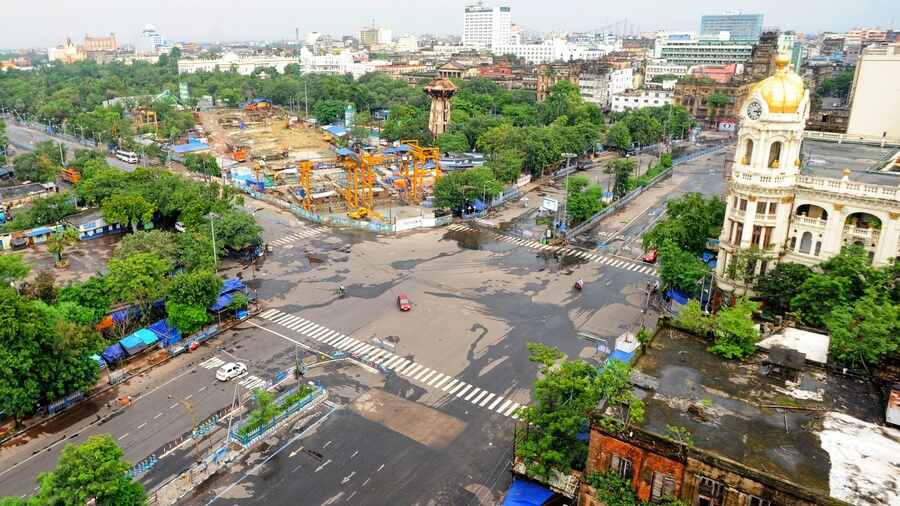Had Beadon Square been a part of any other landscape of any other city of the world, instead of Kolkata, it would’ve perhaps been the most-visited heritage park in the city for sure.
Overloaded with historical importance during India’s freedom struggle, this huge park, situated in the northern part of old Calcutta, is where young boys play cricket or soccer now and people go for morning and evening walks. Its boundaries have been long encroached by hawkers, who now have legal rights to do business on its outer railings — blocking its view from the street.
Beadon Square was planned and developed by Calcutta Municipal Corporation between 1867 and 1870 and named after Governor of Bengal, Sir Cecil Beadon. It was the time when the city of Calcutta was gradually being developed by its town planners and they were decorating it with many large public gardens and parks as a proper backup to match the growing population and fast urbanisation. Close to Beadon Square, is another huge public park named Cornwallis Square. It was also developed around the same time. Cornwallis Square is now known as Hedua or Azad Hind Bagh.

The entrance of the park
A report published in The Statesman, dated May 2, 1886, shows a decorated gas lamp post with an ornamental fountain, presented to the city by one Kaliprasanna Sinha. It was later removed from Dalhousie Square to Beadon Square to make space for the statue of Lord Ashley Eden.
Another report published in The Statesman, dated February 19, 1887, gives details of the illuminated decoration of Beadon Square on the occasion of Queen Victoria’s Golden Jubilee celebration. The report says that at Beadon square, a 30-foot-tall Hindu temple was erected and decorated with “a thousand candles”.
Soon after its development, Beadon Square — situated near Nimtala Ghat and off Beadon Street — became one of the mostcoveted public places for the local residents. Thanks to its proximity to the Ganga and with many theatre halls nearby, like Star, Minerva, National Theatre, Bengal Theatre etc, this park became popular among those who went out for evening entertainment.

A view of the Beadon Square park
It stepped into history in 1896 when the Indian National Congress chose it for their 12th annual session venue, for which delegates came from across India. The session held at the square from December 28-31, 1896, saw noted lawyer and former president of Bombay Municipal Corporation Rahimtulla Mahomed Sayani presiding and he delivered one of the finest presidential speeches of that time from Beadon Square.
History was scripted at Beadon Square when on the first day of the session, a 35-year-old Rabindranath Tagore took to the stage and sang Bankim Chandra Chatterjee’s Vande Mataram in an open public forum. However, it is not clear now in which tune Tagore sang the song that day. Many are of the opinion that Tagore tuned it in his own style. A 1905 recording of Vande Mataram by Tagore was discovered much later and that song is based on Raga Desh Malhar. Whether Tagore sang this version at Beadon Square in 1896 is yet unknown.
It is sad that today there is no marble plaque or any other signage available at Beadon Square to tell us about the historical events that took place there.

Local young boys play cricket or soccer at the park now
Beadon Square became a hotspot of political meetings and demonstrations from the beginning of 20th century and it again created history on October 16, 1905, when the biggest political gathering against the Bengal Partition was organised. Apparently, after taking a bath in the Ganga, a huge crowd gathered here and from this park they hit the streets of Calcutta singing patriotic songs written and composed by Rabindranath Tagore and even tied rakhi on every hand they found on the way. From Beadon Street, the rally went to Pashupati Bose’s house in Bagbazar. Even this historical event has no mention today.
The name Beadon Square appeared in the headlines on all international media when in October 1907 a riot started at this place. According to historian Suranjan Das, on October 2, 1907, at 6pm, a mass meeting was held here under the presidency of one Bipin Bihari Dasgupta. It was a protest meeting against the British police, who had imprisoned five young boys participating in the Swadeshi Movement. At the meeting, the local mob got provoked and that led to a huge attack on police forces for the next two days. It continued till October 4, and all of north and central Calcutta was impacted.

An old photo of Beadon Square KMC Archive
Then what exactly can a heritage enthusiast find at Beadon Square today? Beyond its poorly maintained playground, you can find a small enclosure where there are some important statues of colonial times. These were all erected to pay homage to these great souls, but now hardly anyone looks at those.

Raja Kali Krishna Deb Bahadur's statue at the park
Out of all important statues inside of the park, the most splendid one is an excellent European-styled marble sculpture. This is the statue of Raja Kali Krishna Deb Bahadur, son of Raja Krishna Deb of the Sovabazar royal family and grandson of Nabakrishna Deb — the diwan of Lord Clive. Kali Krishna was born in 1808 and passed away in 1874. He was a great scholar and was fluent in many languages. In 1833, he got the title of Raja Bahadur from the East India Company. Kali Krishna was a leading figure in Calcutta’s intellectual circle and a big advocate of women's education in Bengal. He became a fellow of Calcutta University and also the vice-president of British Indian Association.
After his death, this marble statue of Kali Krishna was imported from London. Built by sculptor George Symonds in 1882, the statue is an excellent example of European stone sculpture — he looks purely Indian but his posture of sitting seems western.

Sita Nath Roy Bahadur's statue at the park
On the other side of the park, there are three more statues — all standing in utter negligence. One that attracts most is that of Sita Nath Roy Bahadur, an iconic figure in Bengal’s industry and commerce of that era. Born in 1854, this man was a member of the Bengal Legislative Council. He was the founder member of Bengal National Chamber of Commerce. He was also the commissioner of Calcutta Corporation, commissioner of Calcutta Port, member of Calcutta Improvement Trust and Sheriff of Calcutta at various points of his life. He died in 1920. His statue was sculpted by Maharashtrian sculptor Vinayak Pandurang Karmarkar. It was the first statue made by any Maharashtrian at Beadon square.
Next to it is another white marble statue of Mahamahopadhyaya Kaviraj Dwarka Nath Sen Kaviratna. Born in 1843, Dwarakanath Sen was one of the greatest exponents of indigenous medicine in India. He was the first to form the Ayurvedic School of Bengal and won the title Mahamahopadhyaya. He died in 1909.

The statue of poet Priyanath Sen at Beadon Square
The statue of poet Priyanath Sen stands next to it. He was a lawyer, book critic, writer and an astrologer too. He was very close to Rabindranath Tagore, Akshay Kumar Baral and Biharilal Chakraborty. He died in 1916 and his statue was erected here after Independence.

Kali Charan Banerjee Memorial
Apart from the statues, Beadon Square houses a unique memorial dedicated to one Kali Charan Banerjee. This memorial was erected by his Christian friends and admirers.
That is all one can see as a tangible existence of Beadon Square, now called Rabindra Kanan. Sad to say there is no initiative taken by the state government yet to uplift the glory of this heritage park, which played such a big part before and during the Partition of Bengal.



